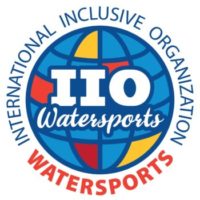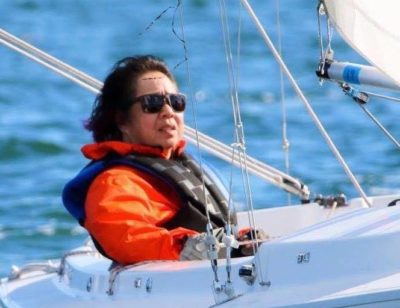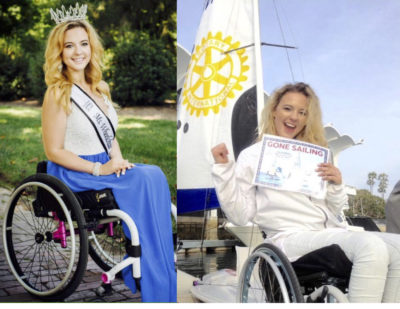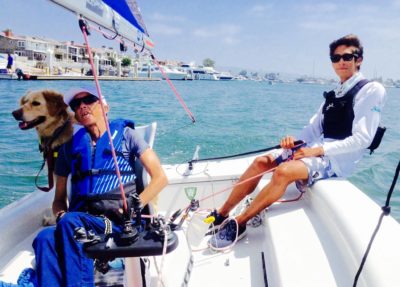PHYSICAL THERAPY ADAPTIVE SAILING
Benefits of Inclusive Sailing Programs For The Therapeutic Rehabilitation of Quadriplegia
By Dawn Brandewie
Orthopedic Physical Therapist
The world is changing, and our health care system is changing with it. With the passing of the Affordable Care Act in 2010, there has been increased focus on wellness to address escalating problems of chronic illness and disease. For people with disabilities, there is increased emphasis on mainstreaming. In a paradigm shift supported by the United States public health and the World Health Organization (WHO), patient management, classification, and treatment has moved away from language of disability towards that of functional levels, with payers basing reimbursement on function and performance. Legislature has been created to provide higher functional level opportunities for special needs populations via inclusion and accommodation. This paper will focus on the subject of physical therapy advocacy for inclusion of tetraplegia into Inclusive Sailing Programs (ICS). Physical therapy advocates for admission of treatment with reimbursement into inpatient and outpatient spinal cord injury rehabilitation programs to include land IT sailing simulation for improved motor coordination, balance, and sailing preparation, followed by on-water adaptive sailing training, for the goal of increased functional autonomy and socialization.
The idea of inclusion began with the passing of the 1990 American Disabilities Act (ADA). This United States labor law prohibits employment discrimination based on disability. It mandated for reasonable provision of public access for disabled individuals as well as for employer accommodations to assist these individuals at the workplace.
The landmark decision of Olmstead v. L.C. expanded this concept of public access for disabled individuals under Title II,stating thatno person with a disability could be unjustly excluded from participation in or be denied the benefits of services, programs or activities of any public entity (ADA, 2016). The new legislature has opened the door for the provision of health care in nontraditional community settings for the purpose of achieving advanced function. Working with disabled individuals in adaptive sports, including adaptive sailing programs, is one example which has been well publicized. Physical therapy advocacy of The Inclusive Sailing Program for quadriplegics is an exciting opportunity to expand on theses current trends in order to initiate early functional treatment of spinal cord injury, demonstrate improved outcomes for payment and funding, expand boundaries existing for inclusion of para and quadriplegias in the sailing community by demonstrating operational feasibility and safety, and create opportunities for SCI patients to work collaboratively with physical therapy and IT in the use of new technological advances to provide increased independent participation in this sport.
Currently, adaptive sailing programs are being utilized by local rotary and community organizations in adjunct to a variety of diagnoses. The movement for quadriplegic utilization of the adaptive sailing program has met with some questions and difficulties secondary to concerns of cost, accommodation, safety, and adaptability.
The rationale for physical therapy advocacy of an adaptive sailing program as treatment for high level paraplegics is to not only address physical health, but to also contribute to improved functional and social well-being. Physical therapy utilization of the program would implement aggressive yet positive functional rehabilitation to patient populations whose injuries have precluded them from most high level sport and, in the process, demonstrate outcomes deserving of insurance reimbursement, government support, and increased public involvement. The early initiation of an adaptive sailing in a patient’s rehabilitation process, in coordination with physical, behavioral and recreational therapy, can lead to more positive outcomes (Rojhani, 2016, p.1). A study performed by Aprile et al (2016) demonstrated the benefits of an adaptive sailing program consisting of a virtual-technological sailing phase, theory-practice phase, and sports phase. Using a proprioceptive platform for measurement, the authors found that trunk displacement and center of pressure velocity improved significantly in healthy and motor and balance impaired subjects ranging from age 9-20. At the end of the program, quality of life was evaluated using the Child Health Questionnaire-PF50, with physical and psychosocial scores significantly improved. Aprile et al. (2017) concluded that technological rehabilitation training improved balance in disabled subjects, was useful in preparation for a real sailing course, and
produced a positive effect on a patient’s general health. They suggested that early initiation of the sport could help it become an integrated part of rehabilitation (Aprile et al., 2017).
A study by Recio et al. (2013), found similar results. The Recio study utilized VSail-Access sailing simulators followed by on water experience in spinal cord injury individuals. The sailing simulation in the early stages of instruction provided a safe and easily supervised method of training. Upon completion of the course, all subjects demonstrated the ability to navigate a simple triangular configuration on the computer screen, and sail independently in winds of up to 14 knots on water. In addition, there were measurable improvements in their psychological health secondary to the ability to participate in a sport with their family members (p.1109). While these findings are fairly consistent throughout adaptive sailing program studies with spinal cord patients, less work has been performed in the area of high level quadriplegia primarily due to difficulty of access, safety issues, lack of adaptability, and the high cost of technology. However, policy expansion for inclusion of high level quadriplegics is possible. A pilot study by Rojhani et al. (2016) demonstrated the success of training a C4 tetraplegia for sailing, utilizing the adaptive sailing program. At the end of the course, the subject was able to sail using a sip and puff and a tiller control mechanism in winds of 5-15 knots. The Rojhani study theorized that, despite trends toward shorter rehabilitation stays, initiation of this program from the continuum of inpatient to post outpatient rehabilitation, created a positive perspective. In addition, it facilitated patient interaction with families and peers, and initiated contact with future support systems like community sailing clubs (Rojhani, 2016).
To improve the continuum of care within this program, local community sailing centers with wheelchair access need to be educated on SCI and high cervical tetraplegia sailing capabilities. The communities need consultation for appropriate access and inclusion of this population. Although costly, marinas may be open to this SCI expansion. Physical therapy use of the inclusive sailing program implementation for para and quadriplegia is possible. Now our profession just needs to facilitate use so that inclusion for this population is complete, and access is truly more than a deference to ADA guidelines, for high cervical quadriplegics.
References:-
United States Sailing Association. Adaptive Sailing Resource Manual. ussailing.org.
Aprile, I.,ILacovelli, C., Iuvone,L, Imbimbo, I., Cruciani, A.,,,,Padua, L. (2016). Use of a virtual-technological sailing program to prepare children with disabilities for a real sailing course: effects on balance and quality of life. Journal of Child Neurology. 31(8)1074-80. DOI: 10.1177/0883073816638756
Davenport, T.E. (2015). Clinical case reporting in the peer-reviewed physical therapy literature: time to move toward functioning. Physiotherapy Research International: The Journal For Researchers and Clinicians in Physical Therapy. 20(4)220-230. DOI: 10.1002/pri.1562
Duarte, T. & Culver, D.M. (2014). Becoming a coach in developmental adaptive sailing: a lifelong learning perspective. Journal Of Applied Sport Psychology. 26(4)441-456. Retrieved from:
Hablutzel, J. (2014). Quality improvement, reimbursement drive quest for patient satisfaction data. Medical Group Management Association. (2014). 14(1)22-23. Retrieved from: http://web.a.ebscohost.com.akin.css.edu/ehost/detail/detail?vid=2&sid=216e5c1b- a16c-4416-9dd6-6dae09396f19%40sessionmgr4007&hid=4204&bdata=JnNpdGU9ZWhvc3Qtb Gl2ZSZzY29wZT1zaXRl#AN=25167636&db=mnh.
Lopez, S., Bourgois, J.G., Tam, E., Bruseghini, P., &Capellini, C. (2015). Cardiovascular and metabolic responses to on-water upwind sailing in optimist sailors. International Journal Of Sports Physiology And Performance. 11(5)615-22. DOI: 10.1123/ijspp.2015-0380
Recio, A.C., Becker, D., Morgan, M., Saunders, N.R., Schramm, L.P., & McDonald, J.W. (2013). Use of a virtual reality physical ride-on sailing simulator as a rehabilitation tool for recreational sports and community: a pilot study. American Journal Of Physical Medicine & Rehabilitation. 92(12) 1104-9. DOI: 10.1097/PHM.0000000000000012.
Rojhani, S., Steins, S.A., &Recio, A.C. (2016) Independent sailing with high tetraplegia using sip and puff controls: integration into a community sailing center. The Journal Of Spinal Cord Medicine. p.1-10. Retrieved from: http://web.b.ebscohost.com.akin.css.edu/ehost/detail/detail?vid=2&sid=f31230e9-7859-4609-a174-b0dc7122122a%40sessionmgr101&hid=118&bdata=JnNpdGU9ZWhvc3QtbGl2ZSZzY29wZT1zaXRl#AN=27415644&db=mnh
Sultz, H. & Young, K. (2014). Health care USA: Understanding It’s Organization and Delivery. (8th ed). Burlington, MA.
WHO.org. Towards a Common Language for Functioning, Disability, and Health. World Health Organization. Retrieved From: http://www.who.int/classifications/icf/training/icfbeginnersguide.pdf



